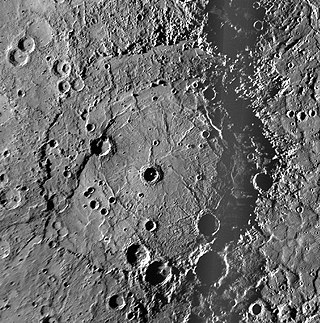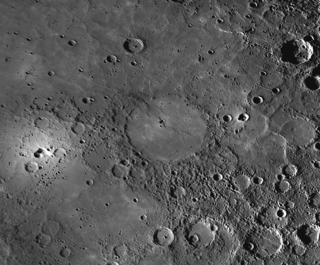
Amalthea is a moon of Jupiter. It has the third closest orbit around Jupiter among known moons and was the fifth moon of Jupiter to be discovered, so it is also known as Jupiter V. It is also the fifth largest moon of Jupiter, after the four Galilean Moons. Edward Emerson Barnard discovered the moon on 9 September 1892 and named it after Amalthea of Greek mythology. It was the last natural satellite to be discovered by direct visual observation; all later moons were discovered by photographic or digital imaging.
Facula is a bright spot on the surface of a planet or a star. It may refer to

Lyctos Facula is a bright mountain on one of Jupiter's smallest moons Amalthea. It is believed to have a width of 25 kilometers and height of 20 kilometers, almost two and a half times higher than Mount Everest . It is one of two named faculae that appear on Amalthea, the other being Ida Facula. It was discovered by Voyager 1 in 1979 and in the same year named for the region of Crete in which Zeus was raised. Firstly it was named simply Lyctos.

Shikoku Facula is a region of bright material on Saturn's moon Titan.

The Hokusai quadrangle (H-5) is one of fifteen quadrangles on the planet Mercury. It runs from 360 to 270° longitude and 20 to 70° latitude. Named after the Hokusai crater, it was mapped in detail for the first time after MESSENGER entered orbit around Mercury in 2011. It had not been mapped prior to that point because it was one of the six quadrangles that wasn't illuminated when Mariner 10 made its flybys in 1974 and 1975. These six quadrangles continued to be known by their albedo feature names, with this one known as the Apollonia quadrangle.

Matisse is an impact crater on the southern hemisphere of Mercury. Matisse takes its name from the French artist Henri Matisse, and it was named by the IAU in 1976.

Raphael is a crater on Mercury. Its name was adopted by the International Astronomical Union (IAU) in 1976, and is named for the Italian painter Raphael.

Memphis Facula is a palimpsest, or "ghost crater", on Ganymede, the largest of the Jovian satellites.

Rembrandt is a large impact crater on Mercury. With a diameter of 716 km it is the second-largest impact basin on the planet, after Caloris, and is one of the larger craters in the Solar System. It was discovered by MESSENGER during its second flyby of Mercury on October 6, 2008. The crater is 3.9 billion years old, and was created during the period of Late Heavy Bombardment. The density and size distribution of impact craters along Rembrandt's rim indicate that it is one of the youngest impact basins on Mercury.

Praxiteles is a crater on Mercury. It is one of 110 peak ring basins on Mercury.

Copland is an impact crater on Mercury. Its floor is flooded with volcanic smooth plains material, which could be related to the activity that formed the nearby bright vent known as Nathair Facula.

Hesiod is a crater on Mercury. It has a diameter of 101 kilometers. Its name was adopted by the International Astronomical Union (IAU) in 1976. Hesiod is named for the Ancient Greek poet Hesiod, who lived around 800 BCE.

Several bright surface features were discovered on the dwarf planet Ceres by the Dawn spacecraft in 2015.

Occator is an impact crater located on Ceres, the largest object in the main asteroid belt that lies between the orbits of Mars and Jupiter, that contains "Spot 5", the brightest of the bright spots observed by the Dawn spacecraft. It was known as "Region A" in ground-based images taken by the W. M. Keck Observatory on Mauna Kea.

Pampu Facula is a bright region on the surface of Mercury, located at 57.76° S, 31.79° W. It was named by the IAU in 2019. Pampu is the Tamil word for snake.

Slang Faculae is a bright region on the surface of Mercury, located at 24.5° N, 179.3° W. It was named by the IAU in 2018. Slang is the Afrikaans word for snake.

Amaru Facula is a bright, irregular depression on the surface of Mercury, located at 49.8° S, 349.5° W. It was named by the IAU in 2018. Amaru is the Quechua word for snake.

Nākahi Facula is a bright, irregular depression on the surface of Mercury, located at 52.7° S, 342.2° W. It was named by the IAU in 2018. Nākahi is the Māori word for snake.

Coatl Facula is a bright region about 49 km wide on the surface of Mercury, located at 29.75° S, 216.55° W. It was named by the IAU in June 2020. Coatl is the Aztec (Nahuatl) word for snake.

















